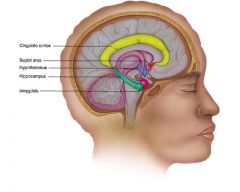![]()
![]()
![]()
Use LEFT and RIGHT arrow keys to navigate between flashcards;
Use UP and DOWN arrow keys to flip the card;
H to show hint;
A reads text to speech;
9 Cards in this Set
- Front
- Back
|
What are the typical parts of the limbic system?
How old is this brain? |

Limbic system is the older part of the mammalian brain
|
|
|
Where is the limbic system located?
|
medial surface of the temporal lobe, medial surface of the mammalian brain
|
|
|
What structures make up the limbic system
|
-Olfactory cortex
-Amygdala -Hippocampus -Hypothalamus |
|
|
Why is the olfactory cortex
important to the limbic system? |
it's important because the limbic system uses odor to associate memories to long term storage
|
|
|
Why is the amygdala important for normal human func?
|
It makes a person feel fear
|
|
|
How does amygdala's processes make a person 'feel fear'
|
sensory input form: visual, auditory, & somatosensory cortices, all together recognize elements/scenes that signal danger.
THEN, output is the 'fight or flight' system takes over. |
|
|
What does the hippocampus do for the limbic system?
|
one of the limbic systems functions is memory. The hippocampus is the structure that helps turn short-term memory into long-term memories
|
|
|
Why is the hypothalamus important?
|
*helps regulate homeostasis
*helps regulate hunger, anger, thirst, sex drive *response to pain *regulated parasympathetic and sympathetic nervous system (which work with tha amygdala) *helps control the pituitary gland |
|
|
What are the main functions of the limbic system
|
-sets emotional tone
-tags events as important -stores emotional memories -modulates motivation -controls appetite -promotes bonding -directly processes sense of smell -reward/reinforce: like the act will re-do it -modulate sexual behavior |

